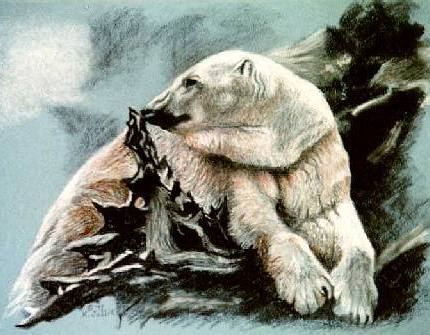|
The original Conté crayon, named after Nicolas- Jacques Conté
was invented to replace a shortage. The purest and best graphite came
from Cumberland in England, with whom the French were at war.
In 1795, Conté developed a way of mixing an inferior grade of graphite
with clay to form a harder instrument that eventually became the modern
graphite pencil.
He made the early Conté crayon by mixing powdered graphite with less clay, and made it in controlled grades of hardness. Today's Conté crayons are a form of refined compressed chalk. |

|
| Conté crayons come in short squared sticks of white, black, and several browns. | |

'Polar Bear', Conté on pastel paper |
Like charcoal, chalks, and pastels, the most striking effects using
Conté crayon are compositions on a colored background. Either
charcoal papers or pastel paper can provide the light "tooth" needed to apply the Conté. They can be colored to supply a midrange of hue against which the white and black show a
contrast. |
| Conté, with its various shades of brown, has a smoother consistency than ordinary chalk, charcoal or pastel, and, due to an oily binder, is harder, less powdery , and adheres more readily. It can be used with more control than all of them, but still has the advantage (and disadvantage) of easily mixing and smearing on the paper with hand, stump or cloth. Like pastels, breaking a stick of Conté is not only not a disaster, but is often required to supply fresh edges, points and sides. | 
|
| |